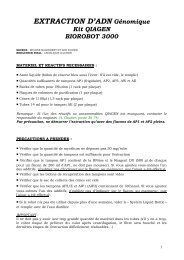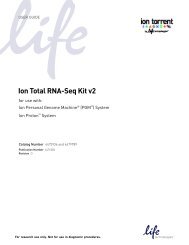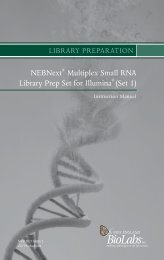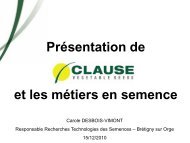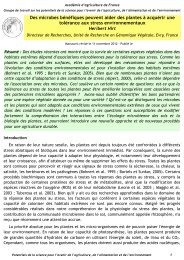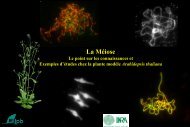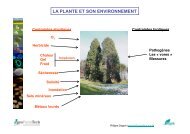The impact of Ty3-gypsy group LTR retrotransposons ... - URGV - Inra
The impact of Ty3-gypsy group LTR retrotransposons ... - URGV - Inra
The impact of Ty3-gypsy group LTR retrotransposons ... - URGV - Inra
Create successful ePaper yourself
Turn your PDF publications into a flip-book with our unique Google optimized e-Paper software.
available in the TREP [42] and NCBI Nucleotide Sequence Databases [45] (Additional File<br />
2). <strong>The</strong> Fatima elements were searched for using the BLASTn algorithm [43] and the<br />
consensus sequences TREP3189 and TREP3198 as reference sequences.<br />
Phylogenetic analysis <strong>of</strong> Fatima sequences coding for conserved domains<br />
Phylogenetic analysis was performed separately for autonomous and nonautonomous<br />
elements. In the case <strong>of</strong> autonomous elements, phylogenetic analysis was based on the<br />
nucleotide sequences corresponding to conserved functional domains AP, RT, RH, and INT.<br />
<strong>The</strong> nucleotide sequences coding for individual domains were determined using BLASTX-2.<br />
<strong>The</strong> consensus amino acid sequences <strong>of</strong> the functional domains AP, RT, RH, and INT for<br />
autonomous Fatima elements were determined by a BLASTP comparison hypothetical<br />
polyprotein PTREP233 consensus sequence and the sequences <strong>of</strong> functional domains and<br />
proteins in the Pfam and NCBI databases. In the case <strong>of</strong> nonautonomous elements,<br />
phylogenetic analysis was performed using the sequences corresponding to the functional<br />
domains GAG and AP. <strong>The</strong> nucleotide sequences encoding these functional domains were<br />
determined similar to the domains for autonomous elements; the consensus hypothetical<br />
protein PTREP231 was used for obtaining the consensus amino acid sequences for the GAG<br />
and AP domains. <strong>The</strong> nucleotide sequences <strong>of</strong> analyzed elements corresponding to the same<br />
functional domains were multiply aligned using the ClustalW program with the MEGA4<br />
s<strong>of</strong>tware package [46, 55]. Phylogenetic trees were constructed by the neighbor-joining<br />
method with the help <strong>of</strong> MEGA4 s<strong>of</strong>tware and a maximum likelihood model with 500<br />
bootstrap replicates and pairwise nucleotide deletion options.<br />
Dating the <strong>LTR</strong> retrotransposon insertion<br />
For dating the insertion events <strong>of</strong> the autonomous and nonautonomous Fatima elements, we<br />
analyzed the nucleotide divergence rate between two <strong>LTR</strong>s in the case when both <strong>LTR</strong>s were<br />
present in the elements’ structure. To determine the <strong>LTR</strong> boundaries, each element was<br />
compared with itself using Blast2seq [http://www.ncbi.nlm.nih.gov/blast/bl2seq/bl2.html/]. In




